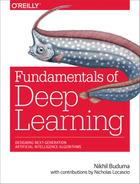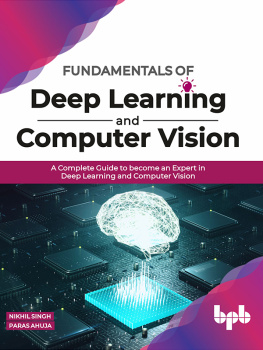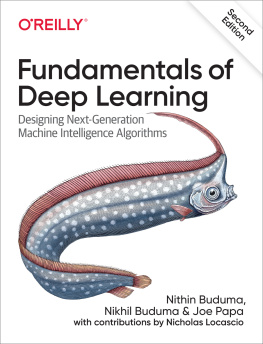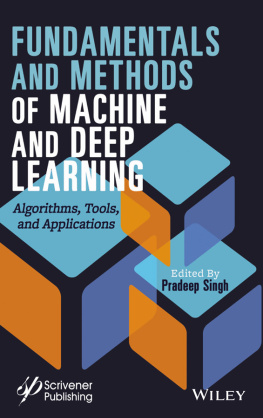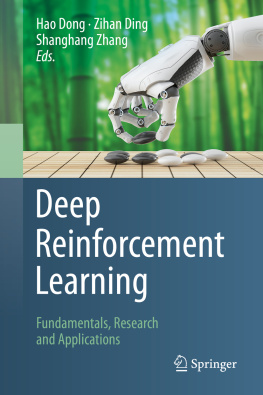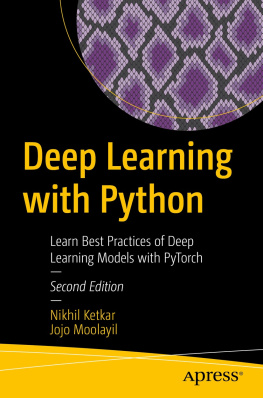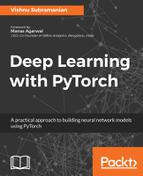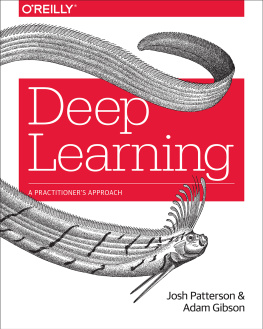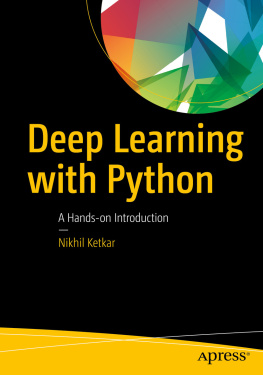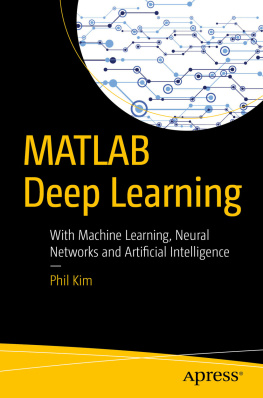Nikhil Buduma - Fundamentals of Deep Learning
Here you can read online Nikhil Buduma - Fundamentals of Deep Learning full text of the book (entire story) in english for free. Download pdf and epub, get meaning, cover and reviews about this ebook. year: 2018, publisher: OReilly Media, Inc., genre: Children. Description of the work, (preface) as well as reviews are available. Best literature library LitArk.com created for fans of good reading and offers a wide selection of genres:
Romance novel
Science fiction
Adventure
Detective
Science
History
Home and family
Prose
Art
Politics
Computer
Non-fiction
Religion
Business
Children
Humor
Choose a favorite category and find really read worthwhile books. Enjoy immersion in the world of imagination, feel the emotions of the characters or learn something new for yourself, make an fascinating discovery.
- Book:Fundamentals of Deep Learning
- Author:
- Publisher:OReilly Media, Inc.
- Genre:
- Year:2018
- Rating:5 / 5
- Favourites:Add to favourites
- Your mark:
- 100
- 1
- 2
- 3
- 4
- 5
Fundamentals of Deep Learning: summary, description and annotation
We offer to read an annotation, description, summary or preface (depends on what the author of the book "Fundamentals of Deep Learning" wrote himself). If you haven't found the necessary information about the book — write in the comments, we will try to find it.
Fundamentals of Deep Learning — read online for free the complete book (whole text) full work
Below is the text of the book, divided by pages. System saving the place of the last page read, allows you to conveniently read the book "Fundamentals of Deep Learning" online for free, without having to search again every time where you left off. Put a bookmark, and you can go to the page where you finished reading at any time.
Font size:
Interval:
Bookmark:
by Nikhil Buduma and Nicholas Lacascio
Copyright 2017 Nikhil Buduma. All rights reserved.
Printed in the United States of America.
Published by OReilly Media, Inc. , 1005 Gravenstein Highway North, Sebastopol, CA 95472.
OReilly books may be purchased for educational, business, or sales promotional use. Online editions are also available for most titles (http://oreilly.com/safari). For more information, contact our corporate/institutional sales department: 800-998-9938 or corporate@oreilly.com .
- Editors: Mike Loukides and Shannon Cutt
- Production Editor: Shiny Kalapurakkel
- Copyeditor: Sonia Saruba
- Proofreader: Amanda Kersey
- Indexer: Wendy Catalano
- Interior Designer: David Futato
- Cover Designer: Karen Montgomery
- Illustrator: Rebecca Demarest
- June 2017: First Edition
- 2017-05-25: First Release
- 2017-07-07: Second Release
The OReilly logo is a registered trademark of OReilly Media, Inc. Fundamentals of Deep Learning, the cover image, and related trade dress are trademarks of OReilly Media, Inc.
While the publisher and the authors have used good faith efforts to ensure that the information and instructions contained in this work are accurate, the publisher and the authors disclaim all responsibility for errors or omissions, including without limitation responsibility for damages resulting from the use of or reliance on this work. Use of the information and instructions contained in this work is at your own risk. If any code samples or other technology this work contains or describes is subject to open source licenses or the intellectual property rights of others, it is your responsibility to ensure that your use thereof complies with such licenses and/or rights.
978-1-491-92561-4
[LSI]
With the reinvigoration of neural networks in the 2000s, deep learning has become an extremely active area of research that is paving the way for modern machine learning. This book uses exposition and examples to help you understand major concepts in this complicated field. Large companies such as Google, Microsoft, and Facebook have taken notice and are actively growing in-house deep learning teams. For the rest of us, deep learning is still a pretty complex and difficult subject to grasp. Research papers are filled to the brim with jargon, and scattered online tutorials do little to help build a strong intuition for why and how deep learning practitioners approach problems. Our goal is to bridge this gap.
This booked is aimed an audience with a basic operating understanding of calculus, matrices, and Python programming. Approaching this material without this background is possible, but likely to be more challenging. Background in linear algebra may also be helpful in navigating certain sections of mathematical exposition.
By the end of the book, we hope that our readers will be left with an intuition for how to approach problems using deep learning, the historical context for modern deep learning approaches, and a familiarity with implementing deep learning algorithms using the TensorFlow open source library.
The following typographical conventions are used in this book:
ItalicIndicates new terms, URLs, email addresses, filenames, and file extensions.
Constant widthUsed for program listings, as well as within paragraphs to refer to program elements such as variable or function names, databases, data types, environment variables, statements, and keywords.
Constant width boldShows commands or other text that should be typed literally by the user.
Constant width italicShows text that should be replaced with user-supplied values or by values determined by context.
Supplemental material (code examples, exercises, etc.) is available for download at https://github.com/darksigma/Fundamentals-of-Deep-Learning-Book.
This book is here to help you get your job done. In general, if example code is offered with this book, you may use it in your programs and documentation. You do not need to contact us for permission unless youre reproducing a significant portion of the code. For example, writing a program that uses several chunks of code from this book does not require permission. Selling or distributing a CD-ROM of examples from OReilly books does require permission. Answering a question by citing this book and quoting example code does not require permission. Incorporating a significant amount of example code from this book into your products documentation does require permission.
We appreciate, but do not require, attribution. An attribution usually includes the title, author, publisher, and ISBN. For example: Fundamentals of Deep Learning by Nikhil Buduma and Nicholas Locascio (OReilly). Copyright 2017 Nikhil Buduma and Nicholas Locascio, 978-1-491-92561-4.
If you feel your use of code examples falls outside fair use or the permission given above, feel free to contact us at .
Safari Books Online is an on-demand digital library that delivers expert content in both book and video form from the worlds leading authors in technology and business.
Technology professionals, software developers, web designers, and business and creative professionals use Safari Books Online as their primary resource for research, problem solving, learning, and certification training.
Safari Books Online offers a range of plans and pricing for enterprise, government, education, and individuals.
Members have access to thousands of books, training videos, and prepublication manuscripts in one fully searchable database from publishers like OReilly Media, Prentice Hall Professional, Addison-Wesley Professional, Microsoft Press, Sams, Que, Peachpit Press, Focal Press, Cisco Press, John Wiley & Sons, Syngress, Morgan Kaufmann, IBM Redbooks, Packt, Adobe Press, FT Press, Apress, Manning, New Riders, McGraw-Hill, Jones & Bartlett, Course Technology, and hundreds more. For more information about Safari Books Online, please visit us online.
Please address comments and questions concerning this book to the publisher:
- OReilly Media, Inc.
- 1005 Gravenstein Highway North
- Sebastopol, CA 95472
- 800-998-9938 (in the United States or Canada)
- 707-829-0515 (international or local)
- 707-829-0104 (fax)
To comment or ask technical questions about this book, send email to .
For more information about our books, courses, conferences, and news, see our website at http://www.oreilly.com.
Find us on Facebook: http://facebook.com/oreilly
Follow us on Twitter: http://twitter.com/oreillymedia
Watch us on YouTube: http://www.youtube.com/oreillymedia
Wed like to thank several people who have been instrumental in the completion of this text. Wed like to start by acknowledging Mostafa Samir and Surya Bhupatiraju, who contributed heavily to the content of Chapters . We also appreciate the contributions of Mohamed (Hassan) Kane and Anish Athalye, who worked on early versions of the code examples in this books Github repository.
This book would not have been possible without the never-ending support and expertise of our editor, Shannon Cutt. Wed also like to appreciate the commentary provided by our reviewers, Isaac Hodes, David Andrzejewski, and Aaron Schumacher, who provided thoughtful, in-depth commentary on the original drafts of the text. Finally, we are thankful for all of the insight provided by our friends and family members, including Jeff Dean, Nithin Buduma, Venkat Buduma, and William, Jack, as we finalized the manuscript of the text.
Font size:
Interval:
Bookmark:
Similar books «Fundamentals of Deep Learning»
Look at similar books to Fundamentals of Deep Learning. We have selected literature similar in name and meaning in the hope of providing readers with more options to find new, interesting, not yet read works.
Discussion, reviews of the book Fundamentals of Deep Learning and just readers' own opinions. Leave your comments, write what you think about the work, its meaning or the main characters. Specify what exactly you liked and what you didn't like, and why you think so.

